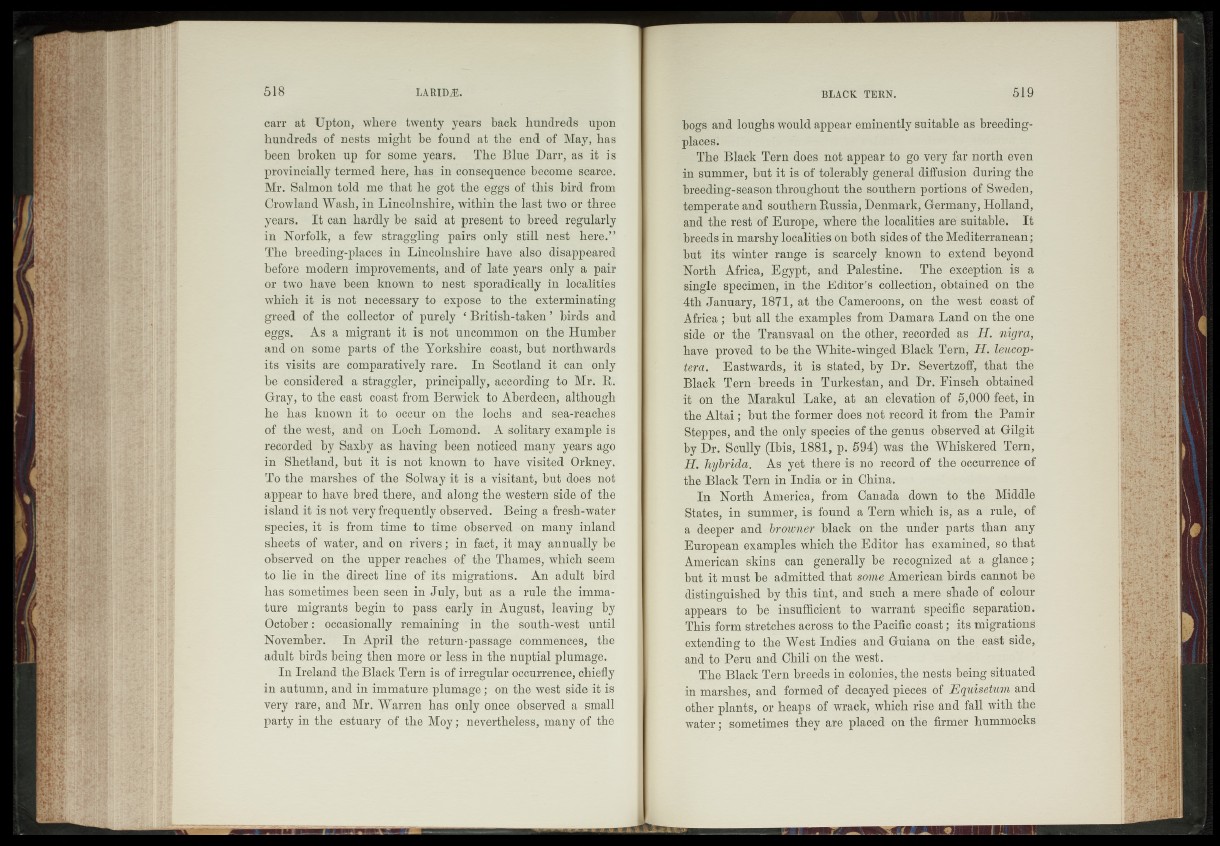
carr at Upton, where twenty years back hundreds upon
hundreds of nests might be found at the end of May, has
been broken up for some years. The Blue Darr, as it is
provincially termed here, has in consequence become scarce.
Mr. Salmon told -me that he got the eggs of this bird from
Crowland Wash, in Lincolnshire, within theTast two or three
years. It can hardly be said at present to breed regularly
in Norfolk, a few straggling pairs only still nest' here.”
The breeding-places in Lincolnshire have also disappeared
before modern improvements, and of late years only a pair
or two have been known to nest sporadically in localities
which it' is not necessary to expose to the exterminating
greed of the collector of purely ‘ British-taken ’ birds and
eggs. As a migrant it is not uncommon on the Humber
and on some parts, -of the -Yorkshire ' obasty but northwards
its visits are comparatively rare-. In Scotland it ean'mnly
be considered a straggler, principally, according-to Mr. R.
Gray, to the east '"coast from Berwick to Aberdeen, although
he/‘has known it to nccqr on/.the lochs and sea-'Teijifes
of the west, and on Loch Lomond. A solitary example is
recorded byJSaxby- as having'been noticed'many years ago
in ’Shetland, but*'it is n6t?!flfdWn to have wisitedc-Orkney.
To the marshes of the Sblwaydbis a visitant,-but^dON&s^not
appear to have bred there, and along the- westeridside >of the
island it is <not|^ity^equently observed. Being' a fresh-water
species, it dslrblh »time to time observed - o'n mahy -inland
sheets of water, and oh riversjMrF'fact, it may-annually Bo
observed on the upper reaches of- the'Tharne's, which-stem
to lie in" the direct" line - of its migrations;.. An adult bird
has sometimes" been seen in July, but as a rule the '.immature
migrants begin to- pass early in>August> teaving %
October ^ occasionally, remaining in^-ihe -south-west utetil
November. ’ In April tnereturn-passage' > commences, ^the
adult birds being then moreioritess in the-nuptial plumage.
In Ireland the Black Tern is of irregular oc6urrehCe-, 'cliefly
ljf autumn, and indmmafure-plumage;“ on thedwhst-sideSfrus
very rare, and Mr. Warren has only once observed a small
party in the estuary of the Moy; ■ nevertheless; many of the
bogs and loughs would appear eminently suitable as breeding-
places;
llfThe Black Tern does not appear_lo go very far north'even
in summer, but it is of tolerably general diffusion during the
breeding-season throughout the southern portions of Sweden,
temperate and southern Russia, Denmark, Germany, Holland,
and the rest of Europe, where the localities are suitable. It
"breeds in marshy localities on both sides of the Mediterranean ;
f u t its winter range is' scarcely known to extend beyond
North Africa, Egypt, and Palestine.- The exception ds; a
single specimen, in the Editor’s collection, obtained -on the
4th January, 1871', at fhe-Cameroons, on -the west .coast of
Africa ; but all the-examples from Damara Land on the‘one
side ’ dr the Transvaal on ; the other, recorded as-, H. nigm-,
have -proved- to be the White-winged Black Tern, M^Àéuêop-
-Ura. Eastwards, it is stated, by Dr. Severtzoff; that the
Black Tern-breeds ’in Turkestan, and Dr. Finsch obtained
ÿ /p n the Marakul Lake, at an elevation of 5,000 feet/in
the Altai'-; but the former does:not record it from the Pamir
-Steppes, and the only species of the genus observed 'at Gilgit
by Dr. Scully (Ibis, 1881, p. 594)fwas the Whiskered Tern,
HC hy&rïda. ] Asvy@t-'theo.?ens no record of the occurrence^ of
the Black Tern in India or in £Shina;-r*
In North America, from Canada down to the Middle
States, in summer, is found a Tern-which is, as a rule," of
a jleeper and black on -the under'parts than any
European examples which the Editor has examined, so that
American skins can generally be recognized at^ a glance ;
but it must be admitted-that some American birds cannot bô
distinguished by-thls-tint/and such a mere shade of colour
appears to be insufficient to warrant specific separation.
This form stretches'across to the Pacific coasb/dtdmigrations
extending todhe West Indies and Guiana on the, east side,
and to Peru and *CË$M.qsIfhe west.
"C The Black Tern breeds in/boloniesythe nests béing'situated
in marshes; and formed of decayed'pièces of Eqmsetvm and
other plants, or heaps, of wrack, which rise and fall with thé.
water; sometimes they are placed on the firmer hummocks